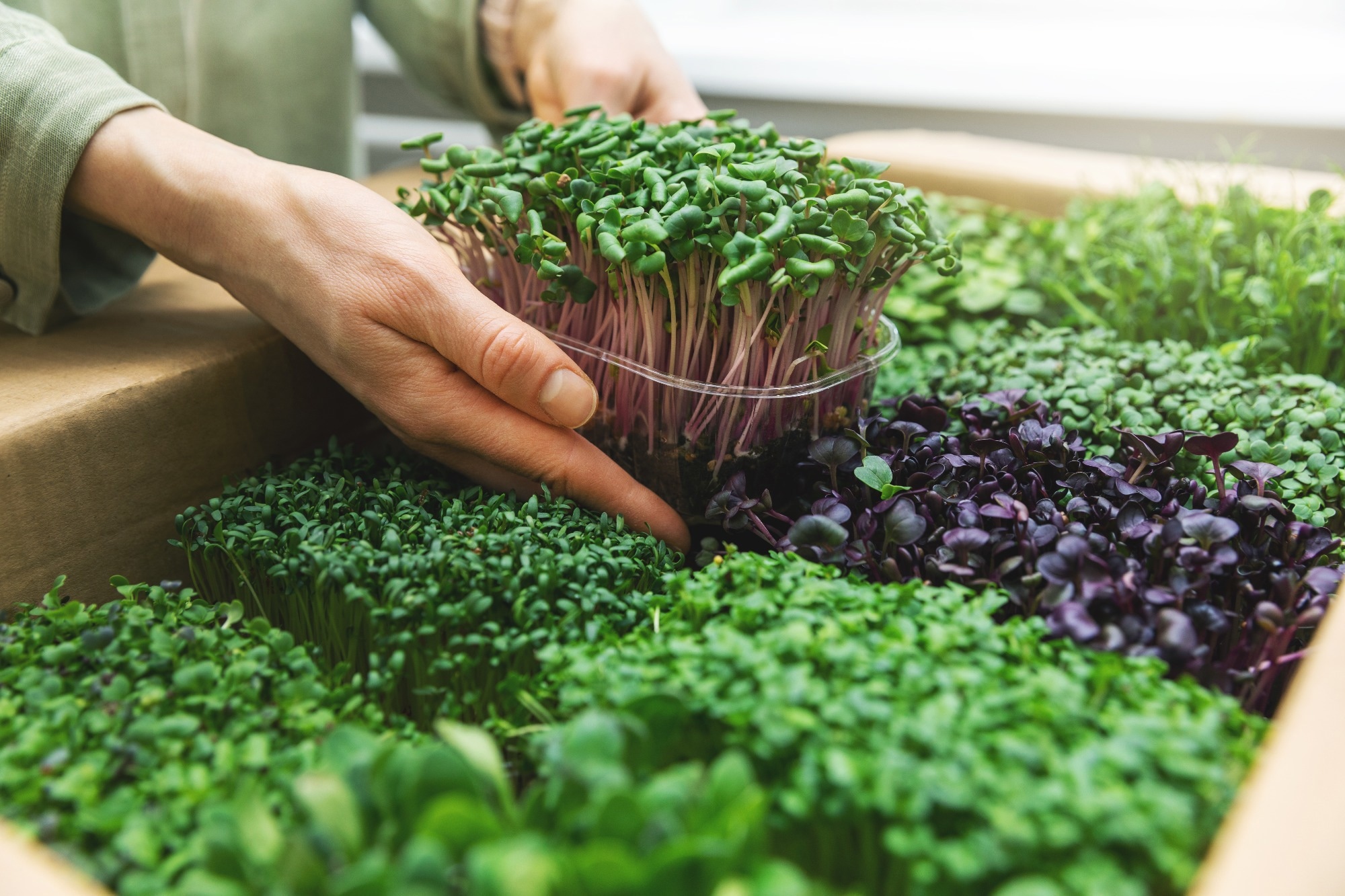
[ad_1]
In a latest evaluate revealed within the journal Heliyon, researchers on the ICAR-Nationwide Bureau of Plant Genetic Sources, New Delhi, collated and synthesized obtainable literature on microgreens, the nutrient-rich seedlings of herbs and greens. They elucidate the historical past and evolution of microgreens, their optimum cultivation strategies, dietary content material, biochemistry, industrial significance, and well being advantages. They additional contact upon challenges and gaps in our understanding of those “desert meals” to tell future cultivators and researchers on one of the best practices to subscribe to when using microgreens.
 Evaluate: Microgreens on the rise: Increasing our horizons from farm to fork. Picture Credit score: ronstik / Shutterstock
Evaluate: Microgreens on the rise: Increasing our horizons from farm to fork. Picture Credit score: ronstik / Shutterstock
What are microgreens?
Following shifting traits generally well being, most notably the introduction and growing adoption of the suboptimal Western eating regimen, a worldwide inadequacy in nutritional vitamins and minerals has been noticed. When mixed with the rising human inhabitants and climate-change-mediated reductions in typical agricultural manufacturing, a necessity arises for novel practical meals characterised by brief turnover occasions, drought resistance, and the comfort of city farming (vertical farms, hydroponics, greenhouses, and aquaponics).
As a conflux of medical, dietary, and organic information, microgreens are one such revolutionary practical meals. ‘Microgreens’ is the colloquial time period for the younger seedlings of edible greens and herbs that haven’t but developed cotyledonary leaves. Analysis has revealed that these vegetation have dietary content material equal to or exceeding 40 occasions their grownup (mature vegetable) counterparts. When mixed with their validated well being and sweetness advantages, cultivation versatility and resilience, and constructive environmental impacts, microgreens are gaining substantial curiosity because the meals of the longer term.
“Since microgreens are a comparatively new specialty meals, there’s not but a big physique of examine on their dietary content material and well being advantages.”
The evolution of microgreens
Whereas the time period ‘microgreens’ is comparatively novel, the follow of consuming unripe greens has been prevalent for many years. Some authors attribute the appearance of contemporary microgreens to cooks’ gardens throughout the Nineteen Eighties in the USA of America (US), the place greens have been grown, shipped, and consumed of their immature state. This follow was additional popularized by stylish eateries that focused the health and health-conscious when advertising and marketing microgreens as extra nutritious than their mature counterparts.
Surprisingly, regardless of microgreens present since earlier than the coining of the time period “practical meals” (yr 2000), a regular definition of those meals and the plant species that comprise them stays elusive. The present evaluate synthesizes an amalgamation of quite a few research’ definitions as follows:
“…microgreens will be described because the germinations of seeds which have absolutely grown real leaves and non-senescent cotyledons, however are eliminated earlier than the event of roots.”
Mass microgreen manufacturing
Microgreens current way more cultivation versatility than their grownup kinds. Regardless of predominantly being grown in managed greenhouse environments, these meals will be cultivated in any setting with secure temperature (< 20 °C) and humidity. Microgreens additionally require a lot much less human labor and area than typical crops – three of 4 people are enough to supply greater than 90 kg of microgreens per week in an space of solely 400 m2. Quick-growing microgreen species can yield harvest in as little as 10 to 14 days.
Pest administration and humidity regulation are essentially the most important variables impacting microgreen yield. Whereas these vegetation are inclined to the identical pests and pathogens as their older counterparts, brief turnover occasions and intrinsic bioactive metabolites decrease these results. In some circumstances, biopesticides and bacterial remedies have confirmed profitable in stopping losses. The latest shift from handbook to machine-controlled humidity regulation and harvesting additional improves microgreen yields in industrial amenities.
Why are microgreens extra nutritious than grownup vegetation?
Analysis has revealed that dormant dry seeds endure important biochemical and dietary modifications (accumulation, remobilization, and disintegration) as soon as their germination is initiated. These processes lead to a ‘condensing’ of vitamins inside edible plant elements, contributing to microgreens’ surprisingly excessive nutrient content material.
As well as, comparisons between germinating and non-germinating seeds and grownup vegetation have proven that the first and secondary metabolite compositions of germinating seeds considerably differ from the opposite two cohorts. Consequently, some kinds of microgreens comprise vitamins unobtainable from grownup crops.
Well being advantages of microgreens
Microgreens are wealthy sources of carbohydrates, proteins, lipids, nutritional vitamins, minerals, and phytochemicals. Medical and case-control trials have revealed the numerous antioxidant potential of those meals and have elucidated their medical potential in controlling (reducing) blood glucose, weight administration, and lowering heart problems (CVD) threat. Phytochemical parts of microgreens are readily digestible and are hypothesized to have antibacterial, anti-diabetic, and anti inflammatory results.
Notably, microgreens from broccoli, radish, and different Brassicaceae representatives comprise phytochemicals reminiscent of indoles and flavonoids with confirmed anti-cancer efficacy in opposition to colorectal most cancers. Additional analysis is required to analyze if these properties prolong to different cancers and microgreen species.
Challenges related to microgreen manufacturing
The principle problem of the microgreen trade is storage – these meals have an particularly brief shelf life with a fast discount in dietary content material throughout storage. A further problem is that of preliminary funding – industrial microgreen amenities require costly and specialised substrates, seeds, equipment, and labor.
The longer term
“In shifting ahead, well-designed medical trials are important to comprehensively elucidate the impression of microgreens on human well being, offering concrete proof for his or her health-improving results. Because the exploration of microgreens continues, their promising attributes place them as a invaluable topic of examine, providing a possible avenue for future developments in preventive and therapeutic drugs.”
[ad_2]